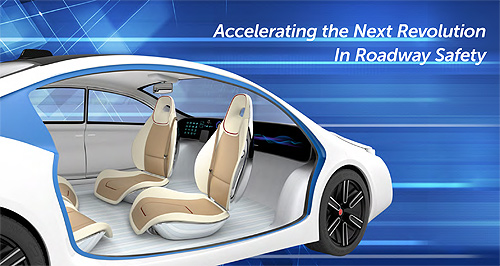News - General News - Autonomous TechnologyUS blessing for autonomous car “revolution”Smarter: American road safety officials are all for autonomous vehicles, saying they can be smarter than humans via collective learning. Green light for driverless vehicle development to save thousands of lives in America21 Sep 2016 THE United States Department of Transport (DOT) has effectively fired the starting gun on autonomous cars, releasing a policy statement calling for accelerated development of “highly automated vehicles” (HAVs) in the interests of safety, energy saving, pollution reduction and other benefits. Brushing aside naysayers who point to accidents such as the well-publicised Tesla autopilot fatal crash in the US as a failure of automation, the official government body and its road safety arm, the National Highway and Traffic Safety Administration (NHTSA), say HAVs might prove to be “the greatest personal transportation revolution since the popularisation of the personal automobile nearly a century ago”. The announcement by the influential authority sets the ground rules for autonomous vehicle testing on public roads in the US and is expected to have a profound knock-on effect in smaller jurisdictions such as Australia where such work is in its infancy. It is also likely to be a major subject of discussion at the Intelligent Transport System World Congress in Melbourne on October 10-15. Pointing to the annual road toll of more than 35,000 deaths in the US alone, the DOT policy statement says 94 per cent of crashes could be tied to human error. “Whether through technology that corrects for human mistakes, or through technology that takes over the full driving responsibility, automated driving innovations could dramatically decrease the number of crashes tied to human choices and behaviour,” it says. “HAVs also hold a learning advantage over humans. While a human driver may repeat the same mistakes as millions before them, a HAV can benefit from the data and experience drawn from thousands of other vehicles on the road. “DOT is also encouraged about the potential for HAV systems to use other complementary sensor technologies such as vehicle-to-vehicle (V2V) and vehicle-to-infrastructure (V2I) capabilities to improve system performance. “These sensor technologies have their own potential to reduce the number and severity of crashes, and the inclusion of V2V and V2I capabilities could augment the safety and performance of HAV systems.” The policy statement says benefits of HAVs do not stop with safety. “Innovations have the potential to transform personal mobility and open doors to people and communities – people with disabilities, ageing populations, communities where car ownership is prohibitively expensive, or those who prefer not to drive or own a car – that today have limited or impractical options. “Cities will reconsider how space is utilised and how public transit is provided. Infrastructure capacity could be increased without pouring a single new truck load of concrete. HAVs may also have the potential to save energy and reduce air pollution from transportation through efficiency and by supporting vehicle electrification.” DOT says it will work with US states to pave the way for uniform regulations on such vehicles for testing by motor companies ahead of “deployment” – the open sale to the public. It says it wants the data from such testing to be shared in a way that allows government, industry and the general public to increase their leaning and understanding while protecting privacy and competitive interests. It concedes that current rules are not only insufficient to govern HAVs but also will require a more flexible and nimble approach to road safety regulation. “The speed with which HAVs are advancing, combined with the complexity and novelty of these innovations, threatens to outpace the agency’s conventional regulatory processes and capabilities,” it says. “This challenge requires DOT to examine whether the way DOT has addressed safety for the last 50 years should be expanded to realise the safety potential of automated vehicles over the next 50 years.” HAV technology is moving so fast that DOT is planning to update the policy statement in just 12 months, incorporating new data, lessons learned in testing and “stakeholder input”. DOT has also opened the document to public comment for two months. But it says it has worked with traffic safety experts, researchers, government, the disabled community and others to formulate its policy so far. “New vehicle technologies developed in the 20th century—from seat belts to air bags to child seats—were once controversial,” it says. “But after having saved hundreds of thousands of American lives, they are now considered indispensable. “Advanced technologies developed in the first part of the 21st century – like automatic emergency braking and lane departure warnings – are already making US roads safer. “How many more lives might be saved today and in the future with highly automated vehicles? DOT is committed to finding out.” The policy statement effectively throws the HAV technology ball into the car manufacturers’ collective courts, but warns that NHTSA has the power to pull any unsafe vehicle off the road. In laying out the ground rules for HAV testing on public roads, DOT says it has adopted the Society of Automotive Engineers (SAE) International definitions of levels of automation based on “who does what, when”. These six definitions range from SAE Level 0, under which the human driver does everything, to SAE Level 5, under which automated systems perform all driving tasks. “Using the SAE levels, DOT draws a distinction between Levels 0-2 and 3-5 based on whether the human operator or the automated system is primarily responsible for monitoring the driving environment,” the policy statement says. “Throughout this policy, the term ‘highly automated vehicle’ HAV represents SAE Levels 3-5 vehicles with automated systems that are responsible for monitoring the driving environment.”  Read more30th of June 2016  Driverless cars lead to MelbourneLatest global autonomous vehicle technologies set to break cover in Australia29th of June 2016  Driverless vehicle data is Here and nowVehicles that 'see around corners' closer as driverless data language gets tick |
Click to shareGeneral News articlesResearch General News Motor industry news |
















Facebook Twitter Instagram